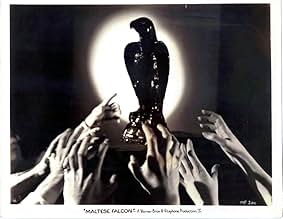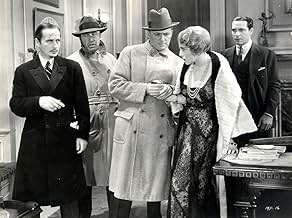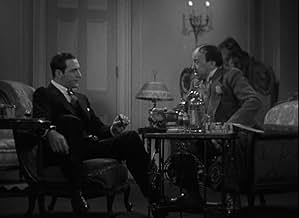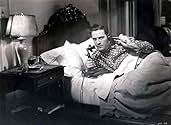अपनी भाषा में प्लॉट जोड़ेंA lovely dame with dangerous lies employs the services of a private detective, who is quickly caught up in the mystery and intrigue of a statuette known as the Maltese Falcon.A lovely dame with dangerous lies employs the services of a private detective, who is quickly caught up in the mystery and intrigue of a statuette known as the Maltese Falcon.A lovely dame with dangerous lies employs the services of a private detective, who is quickly caught up in the mystery and intrigue of a statuette known as the Maltese Falcon.
- पुरस्कार
- कुल 2 जीत
- Capt. John Jacobi
- (बिना क्रेडिट के)
- Jailbird Seeking Cigarette
- (बिना क्रेडिट के)
- Baggage Clerk
- (बिना क्रेडिट के)
- District Attorney
- (बिना क्रेडिट के)
- Sarah - Prison Matron
- (बिना क्रेडिट के)
फ़ीचर्ड समीक्षाएं
As in "Satan Met a Lady", the detective is made out to be a sleazy ladies' man in this movie. When we first see him, he's kissing a woman goodbye; we never actually see her face, but we see her adjusting her stocking, and when Sam returns to his office, the pillows from his couch are in disarray. He seems to be getting some from Effie as well (and I must point out that Una Merkel, as Effie, is hot, hot, hot in this movie; quite a contrast to the matronly Lee Patrick in the 1941 version).
Overall, though, this movie is still somewhat unsatisfying. I suppose if we had never seen the Bogart/Huston version, this would stand as an acceptable adaptation of Hammett's novel (by the standards of the time). It follows the novel fairly closely, but skimps on the plot somewhat. The subplot where Wonderley disappears, and then reappears (as O'Shaughnessy) because she realizes Gutman is in town is missing, as is all the great interplay between Spade and Wilmer ("Just keep riding me, buster", "This'll put you in solid with your boss", etc.) that was such a treat in the later version. True, this movie is a little more explicit about the relationship between Gutman and Wilmer, but Wilmer is such a minor character (with literally only a few minutes of screen time) that their relationship still seems more fully-developed in the 1941 movie. There's also a very odd change at the end (just before the prison scene) that seems like something of a cop-out.
And, finally, it must be pointed out that Ricardo Cortez really stinks in this movie. He spends most of the movie with a smirk plastered on his face, and his performance in general is extremely stiff. I suppose that's to be expected in such an early talkie, but, combined with the general aura of sleaziness that his character exudes, it makes it impossible to really care what happens to him. In the end, this is an enjoyable movie, but mainly for reasons of historical curiosity, and it never comes anywhere near the "classic" status that the later remake has achieved.
I found this version slow going, mainly because it's an early talkie - the dialogue pacing isn't quite right. You can drive a truck through the pauses. The only one with a more modern feel for the dialogue is the handsome, smiling Cortez, and he's absolutely marvelous as Spade. His Spade is more relaxed than Bogie's, less sardonic, more delightfully crooked - in short, he has a lot more fun. He fits just as well into this version as world-weary Bogie does into the 1941 version.
Bebe Daniels is attractive and alluring as the greedy and totally ruthless Miss Wonderly. The gay subplot between Greenstreet and Lorre everyone assumes isn't as apparent in this film between Wilmer (Dwight Frye) and Caspar Guttman (Dudley Digges).
I found the comments in the first post on the actors' approaches to their roles very interesting; I'm not sure I totally agree, but for sure, Cortez spoke louder and Daniels did underplay (which she did not do in "42nd Street" - at all). However, as far as the pace, I still Cortez did better in keeping the dialogue going than anyone else.
This is a fascinating film - so different from the 1941 version, which I hope to see this evening - it's definitely worth catching.
Comparing 1931 v 1941 characters, I think only Sydney Greenstreet provides a more interesting product. As the same (or similar) character, Alison Skipworth, as Madame Barabbas in Satan Met a Lady 1936, finishes second. From that same movie, Marie Wilson finishes second to Una Merkel as Effie, with 1941's Lee Patrick a distant third.
I like them all. I like the structure of the mystery. It reminds me (it's just me) a little of John Le Carre mysteries where, as in Tinker Tailor, the investigator knows the answer from the beginning.
In a nutshell, THE MALTESE FALCON told the story about a San Francisco private detective named Sam Spade, who finds himself drawn into a search for a valuable falcon statuette first created during the Crusades, while investigating three murders.
The story began with a Miss Ruth Wonderly hiring Spade and his partner, Miles Archer, to find her missing sister and a man named Floyd Thursby. When Thursby and Archer end up murdered, Spade discovered that Miss Wonderly is one of three people searching for a statuette called the Maltese Falcon. A mortally wounded ship's captain delivered the statuette to Spade's office before dropping dead, making him the case's third murder victim. The entire case spiraled into a game of cat-and-mouse between Spade, Miss Wonderly, a wealthy fat Englishman named Caspar Gutman and an effeminate continental European named Dr. Joel Cairo. Spade also had to deal with the police, who are determined to pin the three deaths on him.
In the end, this version turned out better than I had expected. However, the movie is not without its faults. There were times when I felt I was watching a filmed play (very common with early talking movies). But the film's main problem seemed to be its pacing. It seemed too slow for what was supposed to be a witty murder mystery. Especially during the first half hour. By the time Joel Cairo was introduced into the story, the pacing finally began to pick up. The dialogue provided by screenwriters Maude Fulton, Brown Holmes and an unaccredited Lucien Hubbard failed to improve over the course of the movie. Not only did the screenplay allow the dialogue to drag throughout the entire film, the latter was not that memorable.
Considering that this is the only precode version of the film, it is not surprising that this version is considered the sexiest of the three filmed versions of the novel. Del Ruth, along with Fulton, Holmes and Hubbard, did an excellent job of conveying the womanizing aspect of Spade's character by revealing his affairs with Archer's wife Iva, his casual flirtation with his secretary Effie, and visual hints of his relationship with Ruth Wonderly like a small indent in the pillow next to the client's head, which hinted that Spade had spent the night with her. Other signs of precode sexuality included Spade bidding a female client good-bye at the beginning of the movie, a nude Miss Wonderly in a bathtub, and a hint of a homosexual relationship between Caspar Gutman and his young enforcer Wilmer Cook.
This version lacked the sharp wit of the 1941 adaptation. Considering that I have never read the novel, the screenplay did allow me to completely understand the story in full detail for the first time, without leaving me in a slight haze of fog. I found nothing memorable about William Rees' photography or Robert M. Haas' art direction except in one scene. The scene in question featured an exterior setting, namely a street in San Francisco's Chinatown where Miles Archer's body was discovered. I suspect that this particular scene gave both Rees and Haas an opportunity to display their artistry beyond the movie's usual interior settings.
There is also a solid cast here. Ricardo Cortez, led the cast as detective Sam Spade. Cortez gave a very sexy interpretation of Spade in his performance. His constant smirks and grins in the film's first ten to fifteen minutes seemed annoying. But in the end, Cortez grew on me. I can honestly say that not only did I find him very effective in portraying a sexy Sam Spade, he also managed to superbly capture the character's cynical humor, toughness and deep contempt toward the police.
Bebe Daniels, another survivor from the silent era, portrayed Ruth Wonderly, and this role has to be considered as one of her best. She managed to give an excellent performance as the ladylike yet manipulative woman who drew Spade into the labyrinth search for the Maltese Falcon. Mind you, she lacked Mary Astor's throbbing voice and nervous manner. But that is merely a minor hitch. Daniels still managed to portray a very convincing elegant temptress.
Irish-born Dudley Digges portrayed the wealthy and obsessive Caspar Gutman, who is not above murder, bribery and a score of other crimes to acquire the falcon statuette. Digges lacked the style to believably portray a man wealthy enough to conduct a twenty-year search for a valuable artifact. Instead, Digges reminded me of a corrupt minor official at a British post in the tropics. He seemed to lack talent and subtlety for infusing menace into his character. Whenever he tried to menacing, he only ended up giving a hammy performance. On the other hand, Otto Matieson gave a more believable performance as Dr. Joel Cairo, Gutman's Continental accomplice. Matieson portrayed Cairo as a no-nonsense and practical man who is careful with his money and with whom to trust it.
Una Merkel gave a humorous performance as Spade's Girl Friday, Effie. Her Effie is not hesitant about expressing her attraction to Spade, yet at the same time, she seemed to find the detective's other amorous activities rather amusing. Todd seemed to be trying too hard as a scorned lover without any subtlety. At least Dwight Frye fared better as Gutman's young enforcer, Wilmer Cook. He did a solid job in conveying the portrait of a baby-faced killer.
I'd suggest watching the 1931 version and the 1941 versions back to back, to get an idea of how Warner Brothers "grew up" during the 1930s. Remember they were just a poverty row studio mainly known for their Rin Tin Tin silent until The Jazz Singer made them rich.
Starring as Sam Spade and Miss Wonderly (who never becomes Brigid O'Shaughnessey) are Ricardo Cortez and Bebe Daniels, the talkies' first immortal guy/gal team. And joining them is the familiar ensemble of grotesques: As `Dr.' Joel Cairo, Otto Mathiessen; as Casper Gutman, Dudley Digges (who, lacking Sidney Greenstreet's girth, is never called The Fat Man); and as Wilmer the gunsel, gimlet-eyed Dwight Frye, familiar from the Dracula and Frankenstein franchises. And while Huston's cast in each instance has the edge, it's not by much these pioneering hams have a field day.
Huston trusted Hammett enough to preserve more of his astringent dialogue intact, but Dangerous Woman shows surprising fidelity to the book. The subplot about Spade's affair with his slain partner's wife Iva Archer stays prominent, and the merry widow is played by Thelma Todd (herself later to fall victim in one of Hollywood's most notorious unsolved murders). Owing to less prudish times, before the Hayes Office tried to make sex un-American, the scene is kept where Spade, in his quest for a palmed $1000 bill, makes Wonderly strip naked (though left largely off-screen). And in calling Wilmer Gutman's `boyfriend,' Spade makes a mite more explicit their old-queen/rough-trade dynamic.
Roy del Ruth, who directed, was an old newspaper man who came to Hollywood in the silent era, racking up a workmanlike list of credits (in 1949, he would return to San Francisco locales for the unusual noir Red Light). He adds some deft touches, as when, after Spade departs with her bankroll, Wonderly blithely extracts a fat wad of bills from her stocking. Much of what he might be credited for, however, may be inadvertent. Since the novel was published and the movie made on that critical cusp between the Roaring Twenties and Old Man Depression, an authentic period tang asserts itself Daniels' marcelled hair, for instance (not to mention the Vienna-born Cortez' being palmed off as a Latin lover).
The movie deviates from the novel in ending with a scene in the women's house of detention that manages to be simultaneously sassy and poignant. Dangerous Female offers an instructive lesson in how the various versions, with their differing tones and emphases, shed their own light and shadow on a classic American crime novel.
क्या आपको पता है
- ट्रिवियाArt director Robert M. Haas performed the same function on The Maltese Falcon (1941).
- गूफ़The same prop is used for the suitcase that Spade finds in Miss Wonderly's room and the suitcase which contains the falcon. The travel stickers are identical on each one.
- भाव
Effie Perrine: Sam, it's a gorgeous new customer.
Sam Spade: Gorgeous?
Effie Perrine: A knockout.
Sam Spade: Send her right in, honey.
Effie Perrine: [to the off-screen customer] Will you step in, please?
[Joel Cairo walks in.]
- कनेक्शनFeatured in Great Performances: Bacall on Bogart (1988)
टॉप पसंद
- How long is The Maltese Falcon?Alexa द्वारा संचालित
विवरण
- रिलीज़ की तारीख़
- कंट्री ऑफ़ ओरिजिन
- भाषाएं
- इस रूप में भी जाना जाता है
- Dangerous Female
- फ़िल्माने की जगहें
- उत्पादन कंपनी
- IMDbPro पर और कंपनी क्रेडिट देखें
- चलने की अवधि1 घंटा 20 मिनट
- रंग
इस पेज में योगदान दें






















